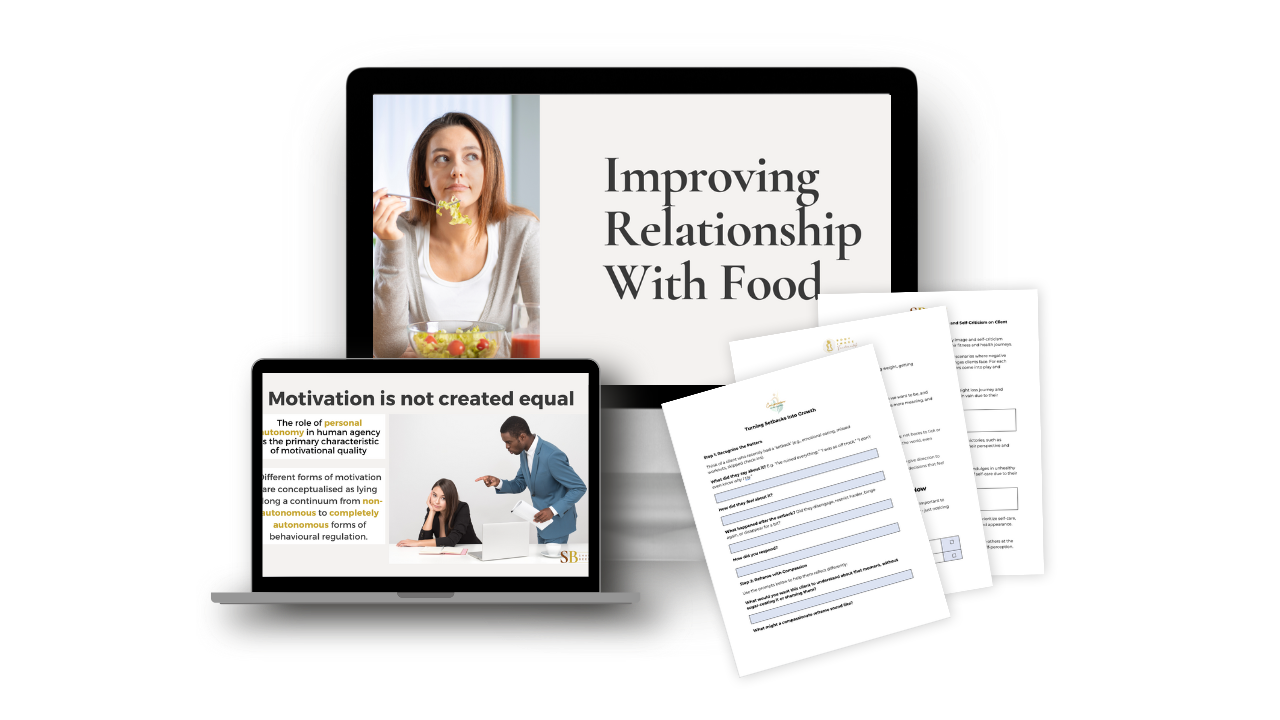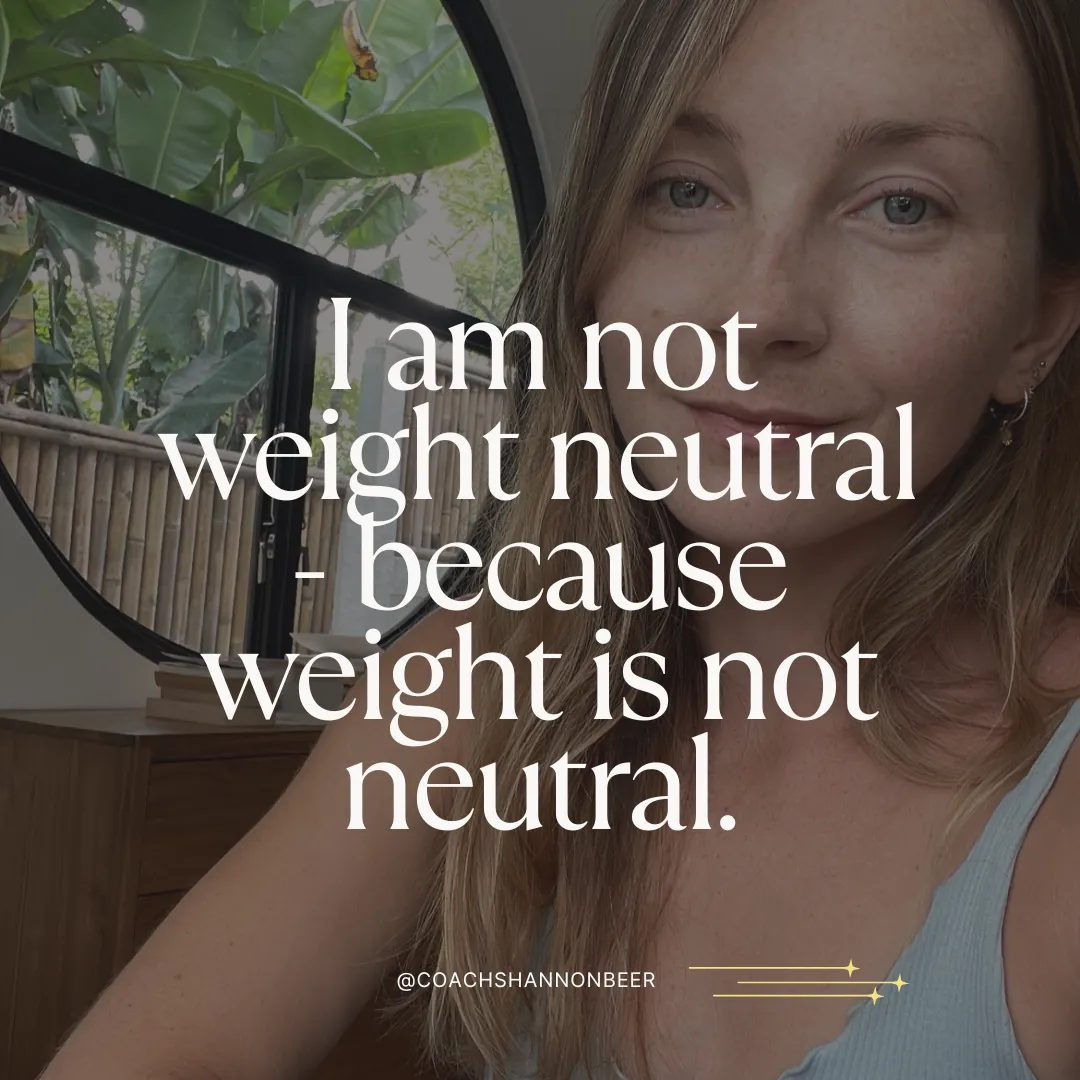How To Deal With Emotions Without Eating
Feb 05, 2022
Emotions are essential to life. They help us to take action, make decisions, communicate how we feel and to understand others. It’s impossible to get through life without experiencing emotions - even negative ones. So it's helpful to learn how to deal with emotions without eating!

Sometimes our emotions can get the better of us. When we feel bad, we often cope in ways that are unhelpful: we withdraw, ruminate, lash out at others, or turn to food. These attempts to avoid or suppress our emotions tend to make us more miserable in the long run. We know this. But sometimes it feels like we’re not the ones in control.
Well, we can be.
We don’t have to be at the mercy of our emotions. Emotional regulation is a skill that can be learned.
How?
Psychological construction approaches to emotion assume that emotions are constructed events rather than fixed entities. Proposedly, the brain uses prior experience to make meaning of the current situation. Our past experiences are stored as concepts in our brain and these form the basis of predictions about what is likely to occur next. From here we can engage in the specific actions that will be of benefit in the particular situation, including actions taken to successfully regulate emotions. The more precise our emotion concepts, the more context-specific predictions we create. This indicates that in order to better regulate our emotions, we need to get good at identifying how we are actually feeling.

Emotional granularity – the ability to make fine-grained distinctions in our feelings – is an important skill that we can learn. In non-clinical samples, higher levels of emotional granularity, particularly of negative emotions, is associated with fewer symptoms associated with depression and anxiety. Higher granularity is also associated with better mental health and healthier coping behaviours, including less alcohol consumption during negative emotional experiences and fewer urges to binge eat. Learning how to differentiate between different emotions can greatly contribute to our health, happiness and ability to handle daily stressors.

TDLR: The more precisely we identify how we’re feeling, the more tailored our actions are, and the more likely they are to be helpful and effective.
So how do we develop emotional granularity?
Mindfulness
Emotion regulation uses mindfulness skills – observing and describing one’s thoughts, emotions and behaviour in a non-judgemental way. You can feel more distressed if you beat yourself up for feeling bad, or if you tell yourself that you shouldn’t feel a certain way.
Mindfulness embodies specific characteristics that may support increase in levels of emotional differentiation:
- Acceptance: increased granularity requires closely examining our experiences. If we’re averse to experiences that we label as ‘bad’, then we’re able to approach and attend to them. A lack of acceptance drives avoidant behaviour.
- Non-identification: realizing that we are not our thoughts may enhance granularity by providing the psychological distance to deploy descriptions of experience that do not conform with our ideas about who we are.
- Dereification: the recognition that our thoughts are not necessarily accurate reflections of reality allows us to set aside habitual conceptualisations and consider things from a different perspective.
Van der Gucht et al. (2019) showed that a mindfulness-based intervention led to improvements in granularity both immediately following the intervention and at a follow-up assessment several months later. Mindfulness-based interventions actively train people to bring their attention to their inner mental states, and to stay with them (even if they are unpleasant) without evaluating or striving to change them.
There are lots of mindfulness practices out there.
Here are some ideas of where to start:
- Guided meditations, such as a body scan or breathing meditation
- An app like Headspace, Calm or Waking Up
- A Mindfulness-Based Stress Reduction Workbook
Affect Labelling
Simply noticing our emotions is a start but it’s probably not going to be enough on its own. It helps to spend time identifying, labelling and interpreting our emotions. Research shows that when we label difficult emotions, the amygdala—a brain structure that registers danger— becomes less active and is less likely to trigger a stress reaction in the body.
Identifying and Labelling Emotions
Instructions: Choose a current or recent emotional reaction and fill out this worksheet in as much detail as possible.
Emotion/s Experienced:
Intensity (0 to 100%):
Activating Event for Emotion/s: What prompted the emotion?
Interpretations of the Situation: Beliefs, assumptions, thoughts, expectations
Body Sensations: The feelings in my body
Actions Taken: What I said or did
Action Urges: What I felt like doing, what I wanted to say
Consequence: The after-effect that my reaction had
What I’d like to do differently: What skills could I use to manage this emotion?
Putting feelings into specific words can have therapeutic effects - evidence links expressive writing and affect labeling to positive health outcomes. It helps to reflect a little on these experiences too. Repeatedly attending to our emotional experiences may provide a context that may facilitate increases in emotional granularity.
Prompts:
What's going on for me right now is…
I feel ____ because ____
Not sure how you’re feeling?
Research suggests that increasing our emotion knowledge can help us differentiate between negative emotions, allowing us to respond to them more effectively. Getting familiar with the differences between certain emotions, and how they show up in our own lives, can help. This typology may a good place to start: https://emotiontypology.com/
A note of caution:
Increased attention to negative experiences may encourage maladaptive forms of rumination. Findings from the expressive writing literature suggest that the use of negative emotion words is non-linearly related to improved wellbeing, such that a moderate number of negative emotion words is associated with greatest benefit. This suggests that past a certain point, attending more often, or at greater length, to one’s negative emotional experiences may no longer be beneficial.
There is a middle ground between avoidance and rumination. Find the right balance for you.
Take Care of Yourself
It’s worth noting that labelling your emotions is far from the only way to regulate them. We can also approach emotional regulation from the bottom up and reduce our vulnerability by taking care of ourselves. Partaking in regular exercise, balanced nutrition, sufficient sleep and nurturing our social connects are ways in which we can leverage our neurobiology in our favour.

To summarise:
- Emotions are essential to life, even the shit ones.
- Avoiding our emotions usually makes us feel worse in the long run.
- Facing our emotions and learning more about them can help us to respond to them more effectively.
- Leveraging our neurobiology through exercise, rest and nutrition can reduce our vulnerability to emotional experiences.
If you need more support to help you take care of yourself, reach out for coaching.
References
Barrett, L. F. (2017). The theory of constructed emotion: An active inference account of interoception and categorization. Soc. Cogn. Affect. Neurosci. 12, 1–23. Doi: 10.1093/scan/nsw154
Barrett, L. F., Gross, J., Christensen, T. C., and Benvenuto, M. (2001). Knowing what you’re feeling and knowing what to do about it: mapping the relation between emotion differentiation and emotion regulation. Cognit. Emot. 15,713–724. doi: 10.1080/02699930143000239
Barrett, L. F., & Russell, J. A. (Eds.). (2015). The psychological construction of emotion. The Guilford Press.
Bishop, S. R., Lau, M., Shapiro, S., Carlson, L., Anderson, N. D., Carmody, J.,et al. (2004). Mindfulness: A proposed operational definition. Clin. Psychol. Sci. Pract. 11, 230–241. doi: 10.1093/clipsy.bph077
Gross, J. J. (2015). Emotion regulation: current status and future prospects.Psychol. Inq. 26, 1–26. doi: 10.1080/1047840X.2014.940781
Hoemann, K., Barrett, L. F., & Quigley, K. S. (2021). Emotional Granularity Increases With Intensive Ambulatory Assessment: Methodological and Individual Factors Influence How Much. Frontiers in psychology, 12, 704125. https://doi.org/10.3389/fpsyg.2021.704125
Kashdan, T. B., Barrett, L. F., and McKnight, P. E. (2015). Unpacking emotion differentiation: transforming unpleasant experience by perceiving distinctions in negativity. Curr. Dir. Psychol. Sci. 24, 10–16. doi: 10.1177/0963721414550708
Lieberman, M. D., Eisenberger, N. I., Crockett, M. J., Tom, S. M., Pfeifer, J. H., & Way, B. M. (2007). Putting Feelings Into Words. Psychological Science, 18(5), 421–428. https://doi.org/10.1111/j.1467-9280.2007.01916.x
Lindsay, E. K., and Creswell, J. D. (2019). Mindfulness, acceptance, and emotion regulation: perspectives from monitor and acceptance theory (MAT). Curr. Opin. Psychol. 28, 120–125. doi: 10.1016/j.copsyc.2018.12.004
Pennebaker, James & Chung, Cindy. (2012). Expressive Writing: Connections to Physical and Mental Health. The Oxford Handbook of Health Psychology. 10.1093/oxfordhb/9780195342819.013.0018.
Pennebaker, J. W., Mehl, M. R., & Niederhoffer, K. G. (2003). Psychological aspects of natural language. use: our words, our selves. Annual review of psychology, 54, 547–577. https://doi.org/10.1146/annurev.psych.54.101601.145041
Smidt, K. E., and Suvak, M. K. (2015). A brief, but nuanced, review of emotional granularity and emotion differentiation research. Curr. Opin. Psychol. 3, 48–51. doi: 10.1016/j.copsyc.2015.02.007
Torre, J. B., & Lieberman, M. D. (2018). Putting Feelings Into Words: Affect Labeling as Implicit Emotion Regulation. Emotion Review, 10(2), 116–124. https://doi.org/10.1177/1754073917742706
Tugade, M. M., Fredrickson, B. L., & Barrett, L. F. (2004). Psychological resilience and positive emotional granularity: examining the benefits of positive emotions on coping and health. Journal of personality, 72(6), 1161–1190. https://doi.org/10.1111/j.1467-6494.2004.00294.x
Van der Gucht, K., Dejonckheere, E., Erbas, Y., Takano, K., Vandemoortele, M., Maex, E., Raes, F., & Kuppens, P. (2019). An experience sampling study examining the potential impact of a mindfulness-based intervention on emotion differentiation. Emotion, 19(1), 123–131. https://doi.org/10.1037/emo0000406
Vedernikova, E., Kuppens, P., & Erbas, Y. (2021). From Knowledge to Differentiation: Increasing Emotion Knowledge Through an Intervention Increases Negative Emotion Differentiation. Frontiers in psychology, 12, 703757. https://doi.org/10.3389/fpsyg.2021.703757
Wilson-Mendenhall, Christine & Dunne, John. (2021). Cultivating Emotional Granularity. Frontiers in Psychology. 12. 10.3389/fpsyg.2021.703658.

Stuck In All Or Nothing Mode?
Your mind isn’t broken; it’s just running on autopilot.
Take the free Emotion System Audit and learn what's driving your patterns - and what to do when you feel overwhelmed or out of control.









